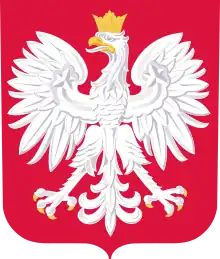Nagana szlachectwa (Latin: 'Vituperatio nobilitatis'), literally reprobation/reprimand/censure of nobility, also translated by Norman Davies as Test of Nobility[1] was a legal procedure of the revocation of nobility in the Polish–Lithuanian Commonwealth.
Descripiton
Due to the absence of formalized heraldry laws and lineage in early Poland, nobility of a person was tested in a regular court.[2] The confirmation of nobility was based on calling for a certain number of witnesses. In Poland this was in accordance with the 1633 statute,[3] in Lithuania by Chapter 3, Article 22 of the 1588 Statute.[4] The latter demanded two witnesses each from the maternal and paternal side. The penalty for perjury was being stripped of one's own szlachta status, by the Constitution of 1601.[5]
In case of the successful nagana, the accuser earned up to half of the property of the accused,[6] with the other half going to the state.[7] The justice was highly prone to miscarriage, in particular, to abusive ennoblement[8] Therefore, this procedure was gradually restricted in various ways. After 1581, the procedures took place before either the Crown Tribunal or the Lithuanian Tribunal.[9]
Norman Davies conjectures that this practice was among the factors leading to the establishment of a unique Polish practice of heraldic clans.[1] It is also asserted that this practice led to development of extensive personal archiving and archive research among Polish nobility.[6]
See also
References
- 1 2 Norman Davies, God's Playground,
- ↑ Semkowicz, W. (1900). Nagana i oczyszczenie szlachectwa w Polsce XIV i XV wieku. Vol. 1. Z druk. W. Łozińskiego. p. 15. Retrieved 2015-06-25.
- ↑ "Volumina legum. Book 3". Ohryzko Jozafat. 1859.
- ↑ "Statut Wielkiego Xięstwa Litewskigo naprzód, za Naiaśnieyszego Hospodara Króla Jegomości Zygmunta III. w Krakowie w Roku 1588... teraz zaś piąty raz, za szczęśliwie panuiącego Naiaśnieyszego Krola jegomości Augusta Trzeciego przedrukowany" (in Polish). Drukarnia Akademicka Soc. Jesu. 1744.
- ↑ "Volumina legum. Book 2". Pan Biblioteka Kórnicka. Ohryzko Jozafat. 1859.
- 1 2 Robert Degen, Wiesław Nowosad. "Archiwa - Kancelarie - Zbiory. Pierwszy polski rocznik archiwozoficzny". home.umk.pl. Retrieved 2015-06-25.
- ↑ Smoleński, Władysław (1919). Dzieje narodu polskiego. Warsaw.
{{cite book}}: CS1 maint: location missing publisher (link) - ↑ Instytut Sztuki (Polska Akademia Nauk) (1991). Polish Art Studies. Zakład Narodowy im. Ossolińskich. ISSN 0208-7243. Retrieved 2015-06-25.
- ↑ Pawlikowski, Michał (2012). Sądownictwo grodzkie w przedrozbiorowej Rzeczypospolitej. Strzałków. ISBN 978-83-933262-1-1.
{{cite book}}: CS1 maint: location missing publisher (link)
External links
- "Wywodzenie szlachectwa – kto jest szlachcicem?", by Artur Ornatowski
